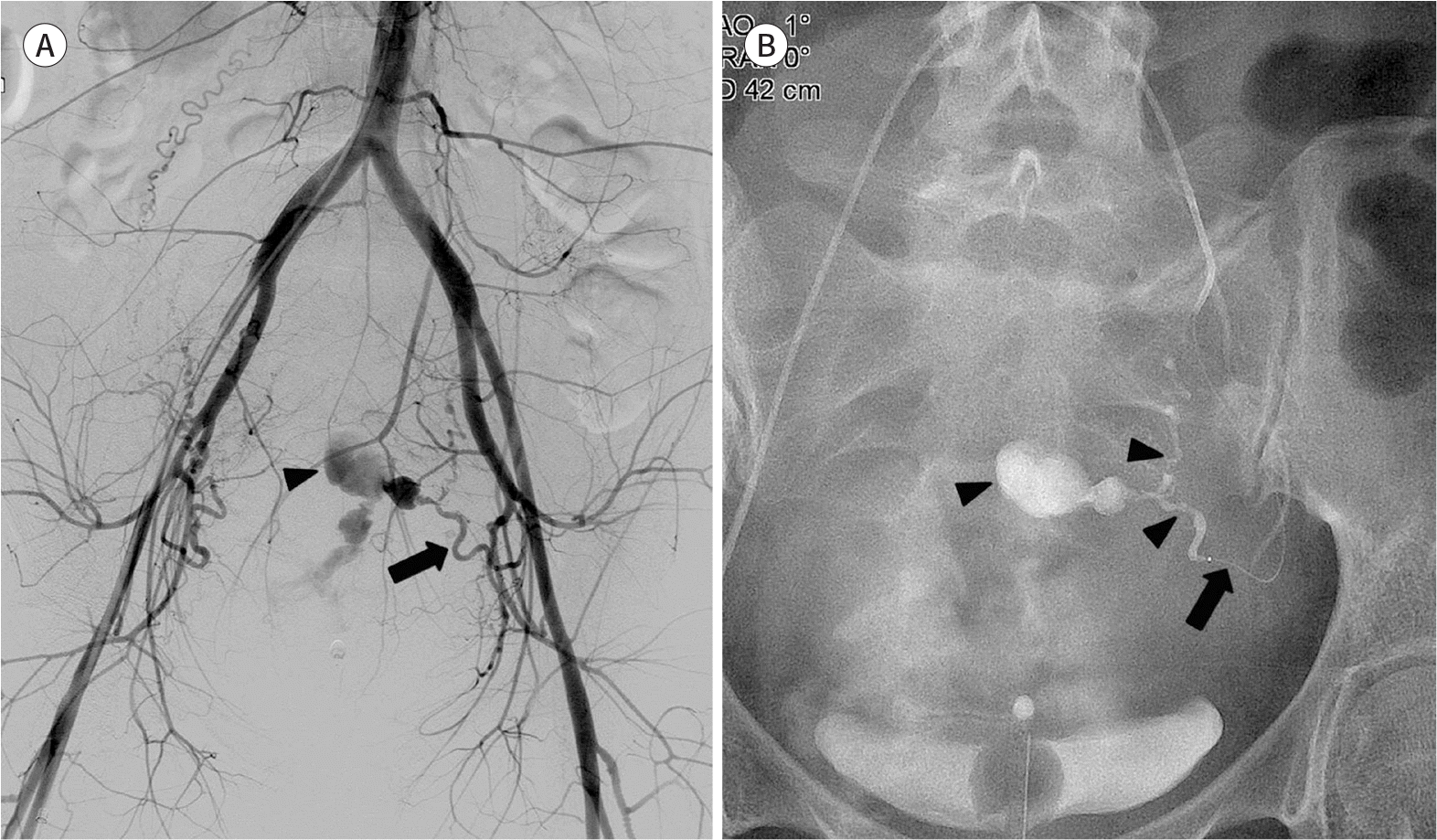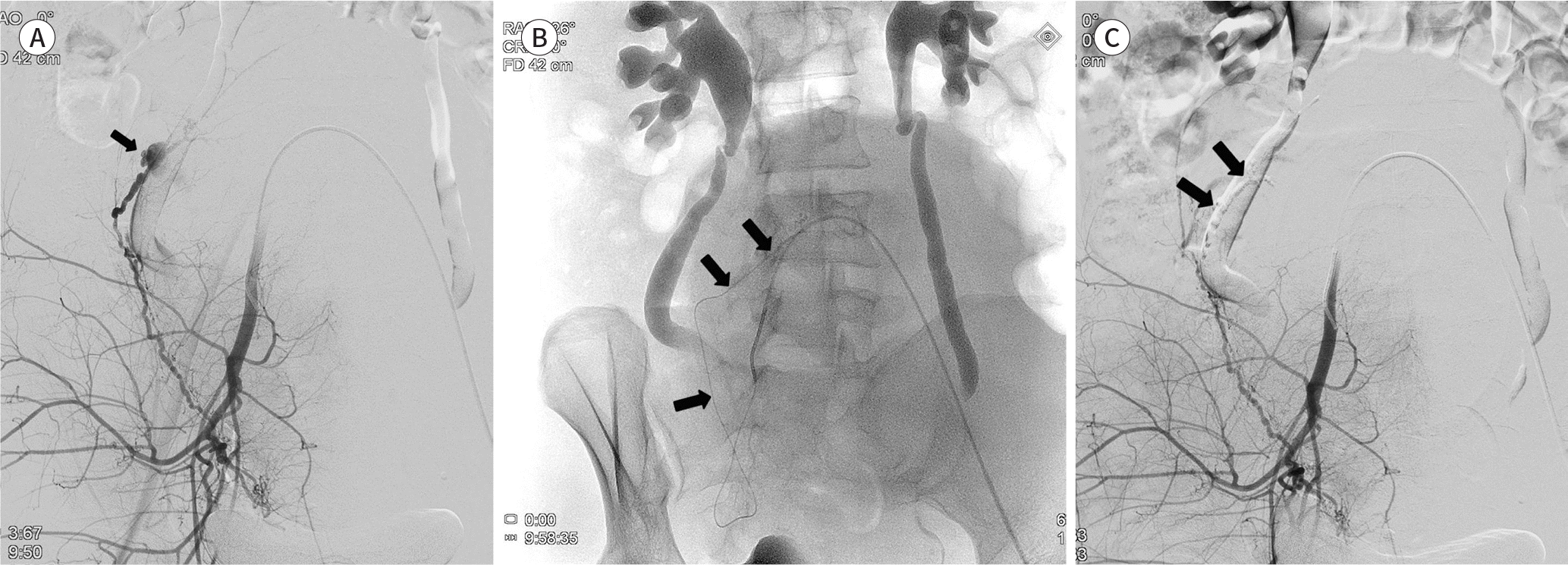Abstract
Purpose
To evaluate the clinical efficacy and safety of uterine artery embolization (UAE) using N-butyl-2-cyanoacrylate (NBCA) in patients with postpartum hemorrhage (PPH).
Materials and Methods
From February 2010 to May 2018, 14 patients (age: 28–39 years; mean: 33 years) underwent UAE using NBCA among 82 patients with PPH. Medical records were retrospectively reviewed to evaluate the patients characteristics, cause of PPH, embolization procedure, and outcomes.
Results
Angiograms revealed extravasation (n = 10) or pseudoaneurysm (n = 4) in all patients. The causes of PPH were hysterotomy or hysterectomy related arterial injury (n = 11), cervical laceration (n = 2), and abnormal placentation (n = 1). UAE was performed with NBCA in all patients. Additional UAE with gelatin sponge particles was performed in two patients. Additional non-uterine artery embolization was performed in three patients. Coagulopathy was found in five (35.7%) patients. The technical and clinical success rates were 92.9% and 85.7%, respectively. One patient died from multi-organ failure eight days after UAE. One patient with abnormal placentation had pelvic organ ischemia due to multiple pelvic artery embolization.
Go to : 
References
1. Khan KS, Wojdyla D, Say L, Gülmezoglu AM, Van Look PF. WHO analysis of causes of maternal death: a systematic review.Lancet. 2006; 367:1066–1074.
3. Revert M, Cottenet J, Raynal P, Cibot E, Quantin C, Rozenberg P. Intrauterine balloon tamponade for management of severe postpartum haemorrhage in a perinatal network: a prospective cohort study.BJOG. 2017; 124:1255–1262.
4. Pelage JP, Le Dref O, Mateo J, Soyer P, Jacob D, Kardache M, et al. Life-threatening primary postpartum hemorrhage: treatment with emergency selective arterial embolization. Radiology. 1998; 208:359–362.

5. Ganguli S, Stecker MS, Pyne D, Baum RA, Fan CM. Uterine artery embolization in the treatment of postpartum uterine hemorrhage. J Vasc Interv Radiol. 2011; 22:169–176.

6. Park JK, Shin TB, Baek JC, Shin JK, Choi WJ, Lee SA, et al. Failure of uterine artery embolization for controlling postpartum hemorrhage. J Obstet Gynaecol Res. 2011; 37:971–978.

7. Gonsalves M, Belli A. The role of interventional radiology in obstetric hemorrhage.Cardiovasc Intervent Radiol. 2010; 33:887–895.
8. Tanahashi Y, Goshima S, Kondo H, Ando T, Noda Y, Kawada H, et al. Transcatheter arterial embolization for primary postpartum hemorrhage: predictive factors of need for embolic material conversion of gelatin sponge particles to N-butyl cyanoacrylate. Cardiovasc Intervent Radiol. 2017; 40:236–244.

9. Matsubara S, Sato T, Nakata M. Vaginal artery embolization with a permanent embolic agent for intractable postpartum hemorrhage.J Obstet Gynaecol Res. 2011; 37:377–378.
10. Koo HJ, Shin JH, Kim HJ, Kim J, Yoon HK, Ko GY, et al. Clinical outcome of transcatheter arterial embolization with N-butyl-2-cyanoacrylate for control of acute gastrointestinal tract bleeding. AJR Am J Roentgen-ol. 2015; 204:662–668.

11. Song HH, Won YD, Kim YJ. Transcatheter N-butyl cyanoacrylate embolization of pseudoaneurysms.J Vasc Interv Radiol. 2010; 21:1508–1511.
12. Yoo DH, Jae HJ, Kim HC, Chung JW, Park JH. Transcatheter arterial embolization of intramuscular active hemorrhage with N-butyl cyanoacrylate. Cardiovasc Intervent Rad/iiol. 2012; 35:292–298.

13. Yonemitsu T, Kawai N, Sato M, Tanihata H, Takasaka I, Nakai M, et al. Evaluation of transcatheter arterial embolization with gelatin sponge particles, microcoils, and n-butyl cyanoacrylate for acute arterial bleeding in a coagulopathic condition. J Vasc Interv Radiol. 2009; 20:1176–1187.

14. Kim GM, Yoon CJ, Seong NJ, Kang SG, Kim YJ. Postpartum haemorrhage from ruptured pseudoaneurysm: efficacy of transcatheter arterial embolisation using N-butyl-2-cyanoacrylate.Eur Radiol. 2013; 23:2344–2349.
15. Park KJ, Shin JH, Yoon HK, Gwon DI, Ko GY, Sung KB. Postpartum hemorrhage from extravasation or pseudoaneurysm: efficacy of transcatheter arterial embolization using N-butyl cyanoacrylate and comparison with gelatin sponge particle.J Vasc Interv Radiol. 2015; 26:154–161.
16. Kanematsu M, Watanabe H, Kondo H, Goshima S, Kato H, Furui T, et al. Postpartum hemorrhage in coagulopathic patients: preliminary experience with uterine arterial embolization with N-butyl cyanoacrylate.J Vasc Interv Radiol. 2011; 22:1773–1776.
17. Lee WH, Yang SB, Goo DE, Kim YJ, Lee JM, Kang CH, et al. Uterine artery embolization: the interventional treatment of female genital diseases. J Korean Soc Radiol. 2017; 76:1–9.

18. Huang YS, Chang CC, Liou JM, Jaw FS, Liu KL. Transcatheter arterial embolization with N-butyl cyanoacrylate for nonvariceal upper gastrointestinal bleeding in hemodynamically unstable patients: results and predictors of clinical outcomes. J Vasc Interv Radiol. 2014; 25:1850–1857.

19. Dohan A, Eveno C, Dautry R, Guerrache Y, Camus M, Boudiaf M, et al. Role and effectiveness of percutaneous arterial embolization in hemodynamically unstable patients with ruptured splanchnic artery pseudoaneurysms. Cardiovasc Intervent Radiol. 2015; 38:862–870.

20. Aina R, Oliva VL, Therasse E, Perreault P, Bui BT, Dufresne MP, et al. Arterial embolotherapy for upper gastrointestinal hemorrhage: outcome assessment.J Vasc Interv Radiol. 2001; 12:195–200.
21. Sacks D, McClenny TE, Cardella JF, Lewis CA. Society of Interventional Radiology clinical practice guidelines. J Vasc Interv Radiol. 2003; 14:S199–S202.

22. Pelage JP, Soyer P, Repiquet D, Herbreteau D, Le Dref O, Houdart E, et al. Secondary postpartum hemorrhage: treatment with selective arterial embolization.Radiology. 1999; 212:385–389.
23. Wang BH, Boulton M, Lee DH, Pelz DM, Lownie SP. A systematic characterization of the factors influencing polymerization and dynamic behavior of n-butyl cyanoacrylate.J Neuro/iinterv Surg. 2018; 10:150–155.
24. Takasawa C, Seiji K, Matsunaga K, Matsuhashi T, Ohta M, Shida S, et al. Properties of N-butyl cyanoacrylate-iodized oil mixtures for arterial embolization: in vitro and in vivo experiments.J Vasc Interv Radiol. 2012; 23:1215–1221.
25. Pelage JP, Le Dref O, Soyer P, Jacob D, Kardache M, Dahan H, et al. Arterial anatomy of the female genital tract: variations and relevance to transcatheter embolization of the uterus. AJR Am J Roentgenol. 1999; 172:989–994.

26. Kim JE, So YH, Kim BJ, Kim SM, Choi YH, Sung CK. Postpartum hemorrhage from non-uterine arteries: clinical importance of their detection and the results of selective embolization.Acta Radiol. 2018; 59:932–938.
Go to : 
 | Fig. 1.A 34-year-old woman presented with postpartum hemorrhage after cesarean delivery. A. Pelvic aortography shows extravasation of contrast material (arrowhead) at the proximal portion of the uterine artery (arrow). B. A radiograph obtained immediately after embolization shows a microcatheter advanced into the uterine artery (arrow) and N-butyl-2-cyanoacrylate filled in the pseudoaneurysm and uterine artery (arrow heads). |
 | Fig. 2.A 38-year-old woman presented with postpartum hemorrhage after vaginal delivery. A. Axial CT scan shows contrast material extravasation at the posterior aspect of the lacerated uterine cervix (arrows). Extravasated contrast material pooling in the posterior fornix of the vagina (arrowheads). B. Bilateral internal iliac arteriography showing extravasation (arrowheads) from bilateral cervical arteries (arrows). C. Post-embolic spot image showing the microcatheter advanced into the cervical artery (arrows) and the casted N-butyl-2-cyanoacrylate at the bleeding focus (arrowheads). |
 | Fig. 3.A 31-year-old woman presented with postpartum hemorrhage after cesarean delivery. A. Right internal iliac arteriography showing extravasation of contrast material at the uterine fundus (arrow). B. A radiograph showing the microcatheter advanced into the far distal uterine arterial branch through the tortuous segment (arrows). C. Post-embolic arteriography showing the casted N-butyl-2-cyanoacrylate at the bleeding segment without reflux to the proximal or distal uterine artery (arrows). |
Table 1.
Basic Characteristics and Laboratory Findings of the Patients Who Underwent Uterine Artery Embolization Using N-Butyl-2-Cyanoacrylate
Table 2.
Angiographic Findings and the Results of Embolization
Table 3.
Supplementary Information of the Patients, Treatment Details, and Outcomes




 PDF
PDF ePub
ePub Citation
Citation Print
Print


 XML Download
XML Download